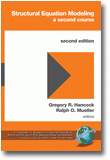
Structural Equation Modeling
A Second Course (2nd ed.)
Edited by:
Gregory R. Hancock, University of Maryland
Ralph O. Mueller, University of Hartford
A volume in the series: Quantitative Methods in Education and the Behavioral Sciences: Issues, Research, and Teaching. Editor(s): Jeffrey R. Harring, University of Maryland.
Published 2013
Sponsored by the American Educational Research Association's Special Interest Group for Educational Statisticians
This volume is the second edition of Hancock and Mueller’s highly-successful 2006 volume, with all of the original chapters updated as well as four new chapters. The second edition, like the first, is intended to serve as a didactically-oriented resource for graduate students and research professionals, covering a broad range of advanced topics often not discussed in introductory courses on structural equation modeling (SEM). Such topics are important in furthering the understanding of foundations and assumptions underlying SEM as well as in exploring SEM, as a potential tool to address new types of research questions that might not have arisen during a first course. Chapters focus on the clear explanation and application of topics, rather than on analytical derivations, and contain materials from popular SEM software.
CONTENTS
Introduction to Series, Ronald C. Serlin. Preface, Richard G. Lomax. Dedication. Acknowledgements. Introduction, Gregory R. Hancock & Ralph O. Mueller. Part I: Foundations. The Problem of Equivalent Structural Models, Scott L. Hershberger & George A. Marcoulides. Reverse Arrow Dynamics: Feedback Loops and Formative Measurement, Rex B. Kline. Partial Least Squares Path Modeling, Edward E. Rigdon. Power Analysis in Structural Equation Modeling, Gregory R. Hancock & Brian F. French. Part II: Extensions. Evaluating Between-Group Differences in Latent Variable Means, Marilyn S. Thompson & Samuel B. Green. Conditional Process Modeling: Using Structural Equation Modeling to Examine Contingent Causal Processes, Andrew F. Hayes & Kristopher J. Preacher. Structural Equation Models of Latent Interaction and Quadratic Effects, Herbert W. Marsh, Zhonglin Wen, Kit-Tai Hau, & Benjamin Nagengast. Using Latent Growth Modeling to Evaluate Longitudinal Change, Gregory R. Hancock, Jeffrey R. Harring, & Frank R. Lawrence. Mean and Covariance Structure Mixture Models, Dena A. Pastor & Phill Gagné. Exploratory Structural Equation Modeling, Alexandre J. S. Morin, Herbert W. Marsh, & Benjamin Nagengast. Part III: Assumptions. Nonnormal and Categorical Data in Structural Equation Modeling, Sara J. Finney & Christine DiStefano. Analyzing Structural Equation Models with Missing Data, Craig K. Enders. Multilevel Structural Equation Modeling with Complex Sample Data, Laura M. Stapleton. Bayesian Structural Equation Modeling, Roy Levy & Jaehwa Choi. Use of Monte Carlo Studies in Structural Equation Modeling Research, Deborah L. Bandalos & Walter Leite. About the Authors.
REVIEWS
"This book represents a significant updating and expansion of Hancock and Mueller's excellent first edition that explores a variety of topics not typically covered in introductory SEM courses. The second edition is again characterized by the substantial strengths of the original text including a clearly articulated didactic presentation style and a cohesive voice that connects each chapter to the next. This revised edition not only incorporates comprehensive updates to the original material but also includes the addition of a number of wholly new chapters covering important and contemporary topics including partial least squares estimation, conditional process modeling, exploratory SEM, and Bayesian estimation. Taken together, this is an indispensible resource for both beginner and advanced users of SEM across the social and behavioral sciences; I recommend it highly." Patrick J. Curran University of North Carolina at Chapel Hill
-
Paperback9781623962449
Web price: $74.28 (Reg. 87.39)
-
Hardcover9781623962456
Web price: $123.16 (Reg. 144.89)
- eBook9781623962463

- EDU029010 - EDUCATION: TEACHING METHODS & MATERIALS: Mathematics
- EDU037000 - EDUCATION: Research
- MAT029000 - MATHEMATICS: PROBABILITY & STATISTICS: General
-
 (Re)Envisioning Social Studies Education Research
Current Epistemological and Methodological Expansions, Deconstructions, and Creations
(Re)Envisioning Social Studies Education Research
Current Epistemological and Methodological Expansions, Deconstructions, and Creations
-
 A Practical Guide to Exemplary Professional Development Schools
A Practical Guide to Exemplary Professional Development Schools
-
 Diversity as Strategic Opportunity
Exploring New Paths to Good Administration
Diversity as Strategic Opportunity
Exploring New Paths to Good Administration
-
 Multilevel Modeling Methods with Introductory and Advanced Applications
Multilevel Modeling Methods with Introductory and Advanced Applications
-
 Multilevel Modeling of Educational Data
Multilevel Modeling of Educational Data
-
 Real Data Analysis
Real Data Analysis
-
 Structural Equation Modeling
A Second Course
Structural Equation Modeling
A Second Course

